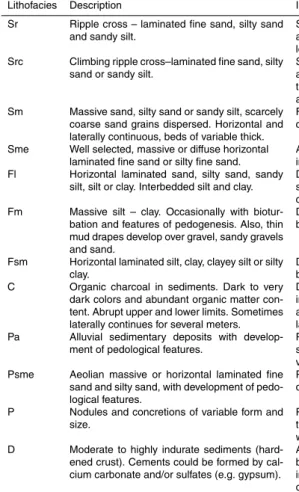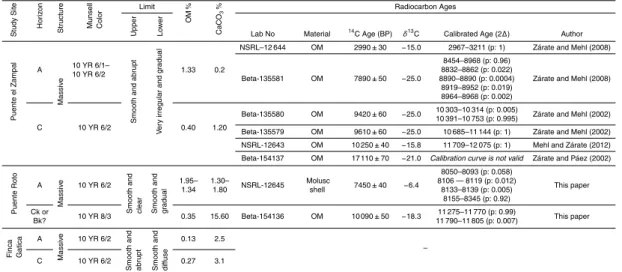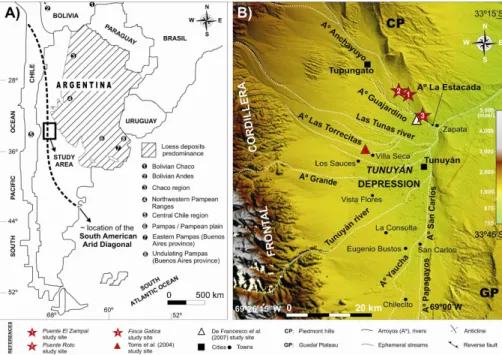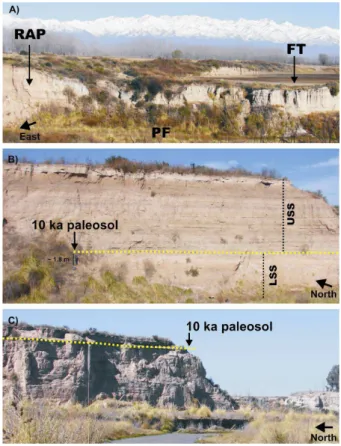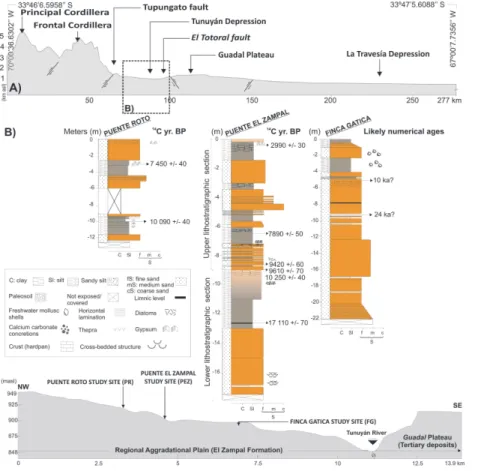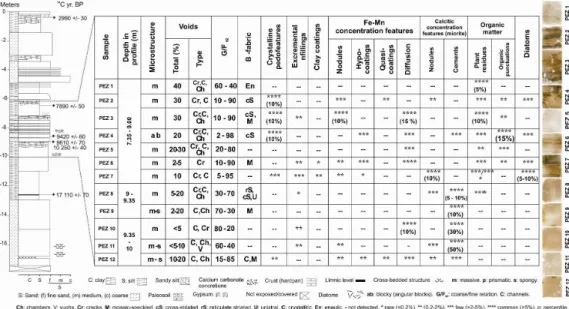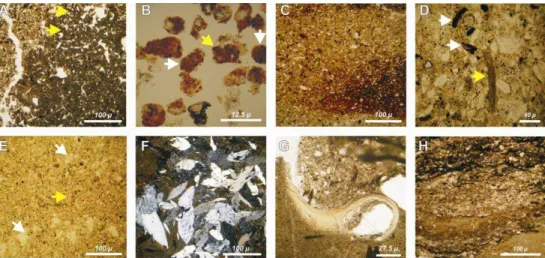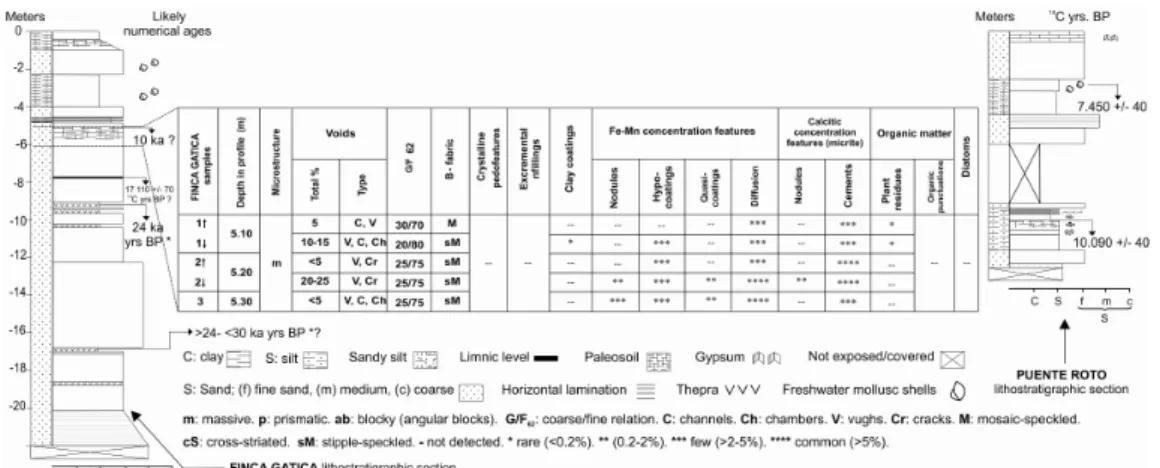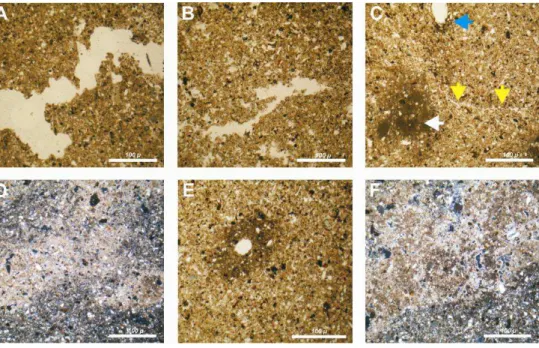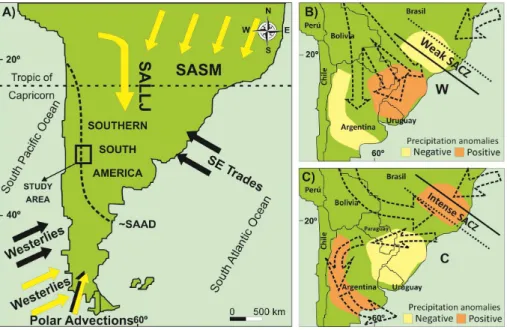CPD
9, 6125–6160, 2013Late Glacial-Holocene climatic transition
A. E. Mehl and M. A. Zárate
Title Page
Abstract Introduction
Conclusions References
Tables Figures
◭ ◮
◭ ◮
Back Close
Full Screen / Esc
Printer-friendly Version
Interactive Discussion
Discussion
P
a
per
|
D
iscussion
P
a
per
|
Discussion
P
a
per
|
Discuss
ion
P
a
per
|
Clim. Past Discuss., 9, 6125–6160, 2013 www.clim-past-discuss.net/9/6125/2013/ doi:10.5194/cpd-9-6125-2013
© Author(s) 2013. CC Attribution 3.0 License.
Open Access
Climate of the Past
Discussions
This discussion paper is/has been under review for the journal Climate of the Past (CP). Please refer to the corresponding final paper in CP if available.
Late Glacial-Holocene climatic transition
record at the Argentinian Andean
piedmont between 33–34
◦
S
A. E. Mehl and M. A. Zárate
Instituto de Ciencias de la Tierra y Ambientales de La Pampa (INCITAP, CONICET), Universidad Nacional de La Pampa, Uruguay 151, Santa Rosa, La Pampa, Argentina
Received: 31 July 2013 – Accepted: 1 October 2013 – Published: 31 October 2013
Correspondence to: A. E. Mehl (adrianamehl@gmail.com) and M. A. Zárate (mzarate@exactas.unlpam.edu.ar)
CPD
9, 6125–6160, 2013Late Glacial-Holocene climatic transition
A. E. Mehl and M. A. Zárate
Title Page
Abstract Introduction
Conclusions References
Tables Figures
◭ ◮
◭ ◮
Back Close
Full Screen / Esc
Printer-friendly Version
Interactive Discussion
Discussion
P
a
per
|
D
iscussion
P
a
per
|
Discussion
P
a
per
|
Discuss
ion
P
a
per
|
Abstract
The Arroyo La Estacada (∼33◦28′S, 69◦02′W), eastern Andean piedmont of
Ar-gentina, cuts through an extensive piedmont aggradational unit composed of a domi-nant late Pleistocene–early Holocene (LP–EH) alluvial sequence including several pa-leosols. The arroyo sedimentary record exhibits a paleosol developed affecting the
top-5
most part of likely Lateglacial aeolian deposits aggraded into a floodplain environment by the end of the late Pleistocene. The paleosol shows variable grade of development in the outcrops along the arroyo probably in relation to fluvial valley paleotopography. Organic matter humification, carbonate accumulation and redox processes were the dominant processes associated with paleosol formation. By the early Holocene, when
10
the formation of the paleosol ended, alluvial aggradation renewed and a higher fre-quency of flooding events could have affected the arroyo’s floodplain environment.
A period of relative landscape stability in the Arroyo La Estacada basin is inferred from the paleosol developed by the LP–EH transition in response to a climatic ame-lioration in the Andes cordillera piedmont after the Late Glacial arid conditions. The
15
renewal of early Holocene alluvial aggradation was probably influenced by the South American Monsoon and resulted in a change in the sedimentary dynamics of the ar-royo.
The analyzed Late Glacial-Holocene alluvial record of the Andean piedmont consti-tutes a suitable record of the LP–EH climatic transition at the extra Andean region of
20
CPD
9, 6125–6160, 2013Late Glacial-Holocene climatic transition
A. E. Mehl and M. A. Zárate
Title Page
Abstract Introduction
Conclusions References
Tables Figures
◭ ◮
◭ ◮
Back Close
Full Screen / Esc
Printer-friendly Version
Interactive Discussion
Discussion
P
a
per
|
D
iscussion
P
a
per
|
Discussion
P
a
per
|
Discuss
ion
P
a
per
|
1 Introduction
The understanding of Earth’s past climatic evolution is considered the key to get a bet-ter understanding of the present day climatic system and the development of longbet-term climatic change forecasts (Saltzman, 2002). In particular, since the Last Glacial Maxi-mum (LGM) the ice sheet retreat and the amelioration of climate leading to our present
5
climate conditions have not been uniform processes (Saltzman, 2002).
In South America, as well as in North America and Eurasia, the final ice sheet re-treat to their present day position may have occurred about 10 kyr ago marking the beginning of the present Holocene interglacial epoch (Saltzman, 2002; Coronato and Rabassa, 2007). Specifically, in the southern tip of the South American continent the
10
Late Quaternary paleoclimatic conditions have been mainly revealed by the glacial dynamic in the Andes Cordillera (Clapperton, 1993; Espizua, 1993, 1998, 1999; Coro-nato and Rabassa, 2007; Rabassa, 2008). More recently, during the last decade there has been increasing interest in Late Quaternary paleoenvironmental and paleoclimatic conditions of the extra Andean region of central Argentina. As a result, researches
15
have been focussed on the analysis of different and varied proxies (Villalba, 1990; Prieto, 1996; Piovano et al., 2002; Zárate and Paéz, 2002; Prieto et al., 2003; Kemp et al., 2006; Boninsegna et al., 2009; Rojo et al., 2012; Navarro, 2012). Specially, the study of buried paleosols has been concentrated in the loess sequences that dominate the Pampean region, where the largest loessic plain of South America develops with
20
a nearly 50 m thick loess record (Fig. 1a). In fact, the eastern region of the Pampean plain has been a classic area to analyse Quaternary argentinean paleosols (Teruggi and Imbellone, 1987; Imbellone and Teruggi, 1993; Blasi et al., 2001; Zárate et al., 2002; Kemp et al., 2004b; Imbellone and Cumba, 2003, among others). Also, some studies were conducted in the loess-paleosol sequence of Northwestern Argentina
25
CPD
9, 6125–6160, 2013Late Glacial-Holocene climatic transition
A. E. Mehl and M. A. Zárate
Title Page
Abstract Introduction
Conclusions References
Tables Figures
◭ ◮
◭ ◮
Back Close
Full Screen / Esc
Printer-friendly Version
Interactive Discussion
Discussion
P
a
per
|
D
iscussion
P
a
per
|
Discussion
P
a
per
|
Discuss
ion
P
a
per
|
14 kyr paleoclimatic–paleoenvironmental conditions (Zárate et al., 2000). As a conse-quence, and taking into account the large potential of South American fluvial systems for paleoclimatic research (Baker, 2000; Zárate et al., 2000; Latrubesse, 2003), many studies have been concentrated in the analysis of alluvial sequences of the Pampean plain (Fidalgo et al., 1973; Zárate et al., 2000; Prieto et al., 2004; Quattrocchio et al.,
5
2008; Zech et al., 2009). Some of them combine information from fluvial sedimentology, pedology and biological proxies and provide all together a more compelling framework for the knowledge of Lateglacial and Holocene paleoenvironmental–paleoclimatic con-ditions in Argentina.
Particularly, in the piedmont of the Andes Frontal cordillera in Mendoza province,
10
central-western Argentina, the record of the Lateglacial and Holocene climatic changes is mainly restricted to the alluvial sequences exposed in the riverbanks of the fluvial systems draining the piedmont (Fig. 1b). At the Arroyo La Estacada fluvial basin (east-ern Andean piedmont,∼33◦28′S and 69◦02′W) there is a well constrained and laterally
traceable paleosol with a formation interval started ca. 12 cal yr BP and lasted until ca.
15
10.6 cal yr BP. The paleosol was developed over likely Lateglacial aeolian silty sands aggraded in the paleo-floodplain environment of the arroyo (Zárate and Páez, 2002; Mehl and Zárate, 2012). A conspicuous change in the depositional arrangement of flu-vial deposits took place after the formation of this paleosol (Zárate and Mehl, 2008; Mehl and Zárate, 2012).
20
Results from field and micromorphological analyses of the late Pleistocene–early Holocene transition in the alluvial sequences exposed at the banks of Arroyo La Es-tacada are presented. The final purpose is to help with the reconstruction of paleoen-vironmental and paleoclimatic conditions of the central-western Argentina during the LP–EH transition. A regional correlation with other synchronous records of the extra
25
CPD
9, 6125–6160, 2013Late Glacial-Holocene climatic transition
A. E. Mehl and M. A. Zárate
Title Page
Abstract Introduction
Conclusions References
Tables Figures
◭ ◮
◭ ◮
Back Close
Full Screen / Esc
Printer-friendly Version
Interactive Discussion
Discussion
P
a
per
|
D
iscussion
P
a
per
|
Discussion
P
a
per
|
Discuss
ion
P
a
per
|
2 Regional setting and geological background
The study area comprises the fluvial basin of Arroyo La Estacada, ∼33◦28′S and
69◦02′W, in Mendoza province, Argentina. The region presents an arid-semiarid cli-mate (Burgos and Vidal, 1951; Prohaska, 1961). The mean annual temperature reaches the 12.8◦C and the ca. 200 mm average annual rainfall is mostly related to
5
short but relatively heavy rains during the austral spring and summer seasons (Barros and Silvestri, 2002). Vegetation corresponds to the “Monte” province according to Cabr-era’s phytogeographical classification (1976) and is dominated by xerophytic shrub-lands (Roig and Martínez Carretero, 1998). Nonetheless hydrophytic communities grow where water is locally available (Rojo et al., 2012). The region is included in the South
10
American Arid Diagonal (SAAD) (Fig. 1a), an ecotone fringe where southern-eastern area has been very sensitive to past and present atmospheric circulation changes (Abraham de Vázquez et al., 2000; Piovano et al., 2009). The SAAD, comprises a nar-row belt of lands that records a moisture source of Atlantic influence towards the north and east (subtropical summer rain regime), and to the western and south-western
ar-15
eas a Pacific influence (mainly dominated by winter precipitations) (Bruniard, 1982; Piovano et al., 2009).
The Arroyo La Estacada drains its waters to the Tunuyán River basin (Fig. 1b), the main river of this piedmont area also receiving inputs from other minor rivers and arroyo systems. The arroyo, of meandering pattern and perennial discharge, is fed by springs
20
located along a fault line and also by Arroyo Anchayuyo, a stream collecting water in a catchment area dominated by Tertiary deposits (Fig. 1b).
The geological setting of the study area corresponds to the piedmont of Frontal cordillera, the eastern morphostructural unit composing the Andes cordillera at this latitude (Fig. 1a and b). Frontal cordillera is formed by a Proterozoic metamorphic
25
CPD
9, 6125–6160, 2013Late Glacial-Holocene climatic transition
A. E. Mehl and M. A. Zárate
Title Page
Abstract Introduction
Conclusions References
Tables Figures
◭ ◮
◭ ◮
Back Close
Full Screen / Esc
Printer-friendly Version
Interactive Discussion
Discussion
P
a
per
|
D
iscussion
P
a
per
|
Discussion
P
a
per
|
Discuss
ion
P
a
per
|
located in the northern tip of the Tunuyán Depression, a Quaternary tectonic basin de-veloped in the piedmont area and filled with Mid to Late Quaternary sediments (Polanki, 1963). The arroyo stream cuts the Tunuyán Depression through an extensive aggrada-tional geomorphological unit called Regional Aggradaaggrada-tional Plain (RAP) sensu Zárate and Mehl (2008) (Figs. 1b and 2a). The RAP is characterized by a flat and gently
5
steepening topography dropping from near 1300 m a.s.l. at the footslope of the Frontal cordillera mountain front to around 700 m a.s.l. at the vicinity of the folded and thrusted Miocene deposits that limit the tectonic depression in its eastern part (Guadal Plateau and Piedmont Hills –Cerrilladas Pedemontanas–; Yrigoyen, 1993; Fig. 1b). The RAP sedimentary sequence is included in the El Zampal Formation (Zárate and Mehl, 2008),
10
previously La Estacada and El Zampal Formations according to Polanski (1963), that would likely record at least the last 120 ka, with the oldest exposures of ca. 50 ka lo-cated along the riverbanks of the arroyos crossing the area (Toms et al., 2004; Zárate and Mehl, 2008). The arroyo La Estacada excavated a nearly 20 m deep valley in the RAP deposits followed by the aggradation of a middle-late Holocene fluvial sequence
15
presently arranged in a fill terrace geomorphological unit (Fig. 2a).
The RAP sedimentary deposits, comprising the LP–EH transition interval, are divided into a lower and an upper stratigraphic section, LSS and USS respectively (Zárate and Mehl, 2008) (Fig. 2b). The LSS is dominantly composed of homogeneous massive sand beds laterally continuous with variable thickness resulting from fluid overflows
20
blanketing inactive areas of sandy braided channels. Also, some hyperconcentrated flow deposits, channel lag and/or longitudinal bar deposits were inferred from the pres-ence of lenses made up of well rounded fine to coarse rock clasts (Mehl and Zárate, 2012). The uppermost 2 m of the LSS record an homogeneous and massive fine sand to silty sand deposit of likely aeolian origin with pedological features on top giving way
25
CPD
9, 6125–6160, 2013Late Glacial-Holocene climatic transition
A. E. Mehl and M. A. Zárate
Title Page
Abstract Introduction
Conclusions References
Tables Figures
◭ ◮
◭ ◮
Back Close
Full Screen / Esc
Printer-friendly Version
Interactive Discussion
Discussion
P
a
per
|
D
iscussion
P
a
per
|
Discussion
P
a
per
|
Discuss
ion
P
a
per
|
The USS develops on top of the paleosol (Fig. 2b). Its base is dominated by horizon-tally laminated and massive bedded sandy silts and clayey silts of variable thickness interbedded with either thin massive, horizontally laminated or ripple cross-laminated fine sand to silty sand layers. Limnic levels are very common throughout these de-posits, with the lowermost yielding a date of 10 391–10 753 cal yr BP (Mehl and Zárate,
5
2012). These sediments were interpreted as deposited from suspension likely blanket-ing inactive areas of sandy braided channels with occurrence of weak traction currents generating lower-flow-regime bed forms (Mehl and Zárate, 2012). The USS middle and upper parts show interbedded massive silty sand and sandy silt layers. Two abutting paleosols develop near the 6 m depth, the upper one dated at 8454–8968 cal yr BP
10
(Mehl and Zárate, 2012). Also, 1.5 m below the surface a paleosol was dated at 2967– 3211 cal yr BP (Zárate and Mehl, 2008). It is overlaid by a moderately to highly hardpan in turn covered by a superficial massive and loose fine aeolian sand blanket (Mehl and Zárate, 2012).
3 Methodology
15
Three locations were chosen to illustrate the different degree of pedological develop-ment of the ca. 10 ka paleosol along the Arroyo La Estacada basin. Fieldwork was carried out at Puente El Zampal (PEZ; 33◦26′52′′S–69◦03′09′′W) and Puente Roto study sites (PR; 33◦26′25′′S–69◦03′32′′W), both located at the riverbanks of the lower reach of Arroyo Anchayuyo (Fig. 3), that contributes its waters, together with Arroyo
20
Guajardino, to Arroyo La Estacada. The third study site selected was Finca Gatica (FG. 33◦28′12′′S–69◦02′19′′W), located at Arroyo La Estacada (Fig. 3). A distance of 1 km exists between PR and PEZ study sites; in turn FG is 4 km and 3 km far away from both study sites respectively (Figs. 1b and 3).
The results obtained from the pedosedimentary analysis of the LP–EH transition
pa-25
CPD
9, 6125–6160, 2013Late Glacial-Holocene climatic transition
A. E. Mehl and M. A. Zárate
Title Page
Abstract Introduction
Conclusions References
Tables Figures
◭ ◮
◭ ◮
Back Close
Full Screen / Esc
Printer-friendly Version
Interactive Discussion
Discussion
P
a
per
|
D
iscussion
P
a
per
|
Discussion
P
a
per
|
Discuss
ion
P
a
per
|
Mehl and Zárate (2012) (Fig. 3; Tables 1 and 2). Field identifications and descriptions were conducted following the main criteria pointed out by Tucker (2003), Catt (1990) and the Soil Survey Staff(1999, 2003). Dry-sediment colors are reported according to Munsell Soil Color Chart (2000) (Table 2). Wet oxidation followed by titration with fer-rous ammonium sulfate was used to determine the organic matter content (Walkley &
5
Black method) in paleosol sediments (Table 2), using the Van Bemmelen factor (1.72) that assumes a 58 % of total organic carbon in soil organic matter. A digital calcimeter was used to determine calcium carbonate content (Table 2).
A micromorphological analysis was conducted to help with the detection of post-depositional pedological features. The PEZ study site was selected as a key section
10
to conduct the micromorphological analysis as it shows the best development of the ca. 10 ka paleosol. The analysis was focused on the depth interval between 7.35 m to 10 m of the alluvial sequence profile (topmost paleosol part is placed approximately at a 9 m depth). On the contrary, FG study site was chosen to analyze the paleosol in a position showing a low degree of pedological development. Due to access difficulties,
15
micromorphological analysis at the FG profile was restricted to the paleosol section of approximately 0.3 m thick, and placed at a depth of near 4.5 m in the alluvial sequence profile.
Micromorphological analysis was carried out in thin sections made from undisturbed blocks collected at convenient intervals in Kubiena tins (7 cm×5 cm×4 cm), then
air-20
dried and impregnated with epoxy resine according to standard procedures (Lee and Kemp, 1992). Thin sections were described under a Nikon Eclipse E400 Pol petro-logical microscope with a 10–400× magnification following the terminology and
cri-teria proposed by Bullock et al. (1985) and Catt (1990). Key micromorphological ob-served features (fabric, structure-microstructure, coarse/fine materials, basic
compo-25
CPD
9, 6125–6160, 2013Late Glacial-Holocene climatic transition
A. E. Mehl and M. A. Zárate
Title Page
Abstract Introduction
Conclusions References
Tables Figures
◭ ◮
◭ ◮
Back Close
Full Screen / Esc
Printer-friendly Version
Interactive Discussion
Discussion
P
a
per
|
D
iscussion
P
a
per
|
Discussion
P
a
per
|
Discuss
ion
P
a
per
|
4 Results
4.1 Macroscopic features of the late Pleistocene-Holocene transition paleosol
4.1.1 Puente El Zampal study site
At PEZ study site the ca. 10 ka paleosol is 9 m below the RAP surface and 7 m above the arroyo Anchayuyo water level (Figs. 2b and 3). It exhibits an A/C profile with a
thick-5
ness of nearly 0.4 m and it is characterized by a massive aspect and high firmness. When broken in the hand it has blocky appearance. Color varies downward from gray (10YR 5/1, 6/1)-light brownish gray (10YR 6/2) to light gray (10YR 7/1, 7/2) (Table 2). Organic matter decreases in the same way from 1.33 % to 0.40 % while calcium car-bonate content passes downward from non-calcareous to very slightly calcareous
(Ta-10
ble 2). Approximately 0.65 m below the paleosol there are calcitic nodules grading into calcitic mottles towards the lower levels. Numerical ages reported for this paleosol were obtained from the topmost and lowermost part of the A horizon: 10 685–11 144 cal yr BP and 11 709–12 075 cal yr BP respectively (Table 2).
4.1.2 Puente Roto study site
15
At this study site the paleosol is 10 m below the RAP surface and near 10 m above the arroyo Anchayuyo water level (Fig. 3). It exhibits an upper A horizon and a preliminary described Ck or Bk horizon. Faint color changes downward in a gradual way from light brownish gray (10YR 6/2) to very pale brown (10YR7/3, 8/4) (Table 1). Organic matter content reaches up to 2 % but decreases markedly toward the paleosol base
20
(Table 1). Calcium carbonate content changes from slightly calcareous in the paleosol upper part to very calcareous in the base exhibiting calcitic nodules. Also, there are calcitic concretions at a depth of approximately 0.6 m below the paleosol (Table 1). A calibrated radiocarbon age of 11 275–11 805 yr BP was reported from the organic matter content of the paleosol topmost part (Table 2).
CPD
9, 6125–6160, 2013Late Glacial-Holocene climatic transition
A. E. Mehl and M. A. Zárate
Title Page
Abstract Introduction
Conclusions References
Tables Figures
◭ ◮
◭ ◮
Back Close
Full Screen / Esc
Printer-friendly Version
Interactive Discussion
Discussion
P
a
per
|
D
iscussion
P
a
per
|
Discussion
P
a
per
|
Discuss
ion
P
a
per
|
4.1.3 Finca Gatica study site
At FG study site, the LP–EH paleosol is placed at a depth of 4.5 m from the RAP surface and near 15 m above the arroyo La Estacada water level. In this location, the paleosol exhibits a relative higher paleotopographic position and a poorer degree of pedological development when compared with PEZ and PR exposures (Fig. 3). It shows a thickness
5
of 0.3 m, an A–C horizonation and a massive structure. Color changes from light brown-ish gray (10YR 6/2) in the paleosol upper part to very pale brown (e.g. 10YR7/3, 8/4) at the base (Table 1). Paleosol organic matter content is low showing a very little incre-ment downward (Table 2). The same happens with calcium carbonate content resulting in a slightly calcareous paleosol base (Table 2), where some isolated powdery
concen-10
trations of calcium carbonate can be observed. The paleosol has not been dated at this place. Nonetheless its age was inferred from its position 10 m above a tephra level correlated with the 24 to 30 ka BP tephra layers dated by Toms et al. (2004) at Brazo Abandonado (33◦28′13′′S and 69◦02′39′′W) study site, 1.5 km downstream from FG
study site.
15
4.2 Micromorphological aspects
4.2.1 Puente El Zampal micromorphology
The deposits immediately underlying the ca. 10 ka paleosol (Samples: PEZ 10, 11 and 12. Fig. 4) exhibit homogeneous coarse silt and sandy silt to clay sediments (∼C/F62:
80–20, 60–40 and 15–85) without an appreciable organic matter content and a relative
20
dearth of bioturbation features. The matrix is characterized by a massive microstructure and a crystallitic B-fabric. Typic calcitic nodules and zones with diffuse impregnation of calcium carbonate are a common feature of these samples, occasionally associated to a spongy microstructure (Fig. 5a). There are few calcitic hypocoatings around voids. Rare clay hypo-coatings and excrements infilling voids are observed along the
sec-25
CPD
9, 6125–6160, 2013Late Glacial-Holocene climatic transition
A. E. Mehl and M. A. Zárate
Title Page
Abstract Introduction
Conclusions References
Tables Figures
◭ ◮
◭ ◮
Back Close
Full Screen / Esc
Printer-friendly Version
Interactive Discussion
Discussion
P
a
per
|
D
iscussion
P
a
per
|
Discussion
P
a
per
|
Discuss
ion
P
a
per
|
tephra, diatoms or phytoliths) could also be seen. Very few to few ferruginous features (nodules, hipo-quasicoatings and diffusion features) (Fig. 5c) are also observed.
The LP–EH transition paleosol (Samples: PEZ 8 and 9, Fig. 4) shows a sedimen-tary matrix dominated by sandy silt to silty sand textures (∼C/F62: 30–70 and 70–30,
Fig. 4). The upper soil horizon, attributable to an A horizon (Sample: PEZ 8, Fig. 4),
5
presents a weak grade of pedality and a B-fabric varying across the thin section among cross-striated, reticulate striated and unistral. Although the soil mass exhibits a gen-eral homogeneous appearance related to a massive microstructure, some thin sec-tion areas exhibit spongy microstructure linked to bioturbasec-tion features (channels and chambers, some of them showing mamillate surface walls). There are spheroid
aggre-10
gates smaller than 74µassociated to voids in turn excremental features are rare. This soil horizon has common partially degraded plant residues (Fig. 5d) with a dominant random distribution. Nevertheless few root fragments are preserved inside vertical to subvertical channels. Few calcitic nodules and common cemented zones are observed along with concentrations of isotropic materials assigned to glass shards.
15
Although the lower C horizon (Sample: PEZ 9, Fig. 4) shows a dominant massive microstructure, scarce zones develop weak spongy microstructure (Fig. 5e). The sed-imentary matrix is formed mainly by very fine sand to coarse silt grains (∼C/F62: 70– 30). Nonetheless a mosaic-speckled B-fabric can be observed due to the presence of clays in the soil mass. Organic matter concentration is not appreciable in this soil
hori-20
zon; there are common weak calcitic impregnations (>10 %) that turn stronger in the upper and lower zone of the thin section. Also some rare calcitic hypo-coatings develop around voids and some scarce ferruginous concentrations are observed.
The 1.5 m thick sedimentary deposit resting on the LP–EH transition paleosol (Sam-ples: from PEZ 1 to 7. Fig. 4) exhibits laminated horizontal layers with variable grain
25
CPD
9, 6125–6160, 2013Late Glacial-Holocene climatic transition
A. E. Mehl and M. A. Zárate
Title Page
Abstract Introduction
Conclusions References
Tables Figures
◭ ◮
◭ ◮
Back Close
Full Screen / Esc
Printer-friendly Version
Interactive Discussion
Discussion
P
a
per
|
D
iscussion
P
a
per
|
Discussion
P
a
per
|
Discuss
ion
P
a
per
|
gypsum crystal aggregates are common in some samples (Samples: PEZ 2, 3 and 4, Fig. 5f). In general, calcitic concentrations are scarce. Although voids reach up to 40 % of the thin section surface, there are areas with a porosity of just a 2 %. Most of the voids correspond to channels and chambers. Excrements, when present, are linked to voids. Rare clay coatings are observed inside some chambers (Fig. 5g). Plant residues
5
exhibiting a horizontal alignment, root fragments including among them, are common in some levels (Fig. 5h). Besides organic matter punctuations are common in the lower levels of this interval where common to few diatoms are also observed.
4.2.2 Finca Gatica micromorphology
At FG study site, the ca. 10 ka paleosol profile is dominated by silt to clay sediments
10
(∼C/F62: 30–70; Fig. 6). Porosity varies across the paleosol reaching up to 10–15 %
in the upper horizon where voids are related to vughs and channels, the latter mostly likely linked to roots. Some chambers with mamillate surface roughness are observed (Fig. 7a and b). Porosity increases to 20–25 % in the middle paleosol zone correspond-ing mainly to vughs and cracks (Fig. 7c), the first probably relate to soil micro-fauna
15
activity. At the paleosol base some channels and chambers can be recognized, but porosity is in general lower than 5 %.
Calcitic concentration features are seen throughout the profile. Micrite is most abun-dant in the middle paleosol section and is possibly linked to water movement through the soil mass (Fig. 7c and d). In turn, at the top and base of the paleosol most of the
mi-20
critic concentrations are restricted to voids (Fig. 7e), likely in relation to water passing through them or to plant roots respiration. However some rare diffusion features can be observed at this section (Fig. 7f). Typic micrite nodules appear in a small proportion (0.2–2 %) at the basal horizon.
Ferruginous and manganiferous concentration features are also present in the soil
25
CPD
9, 6125–6160, 2013Late Glacial-Holocene climatic transition
A. E. Mehl and M. A. Zárate
Title Page
Abstract Introduction
Conclusions References
Tables Figures
◭ ◮
◭ ◮
Back Close
Full Screen / Esc
Printer-friendly Version
Interactive Discussion
Discussion
P
a
per
|
D
iscussion
P
a
per
|
Discussion
P
a
per
|
Discuss
ion
P
a
per
|
diffusion features are linked to almost a 70 % of the voids. Additionally, middle and lower parts exhibit few nodules and very few quasicoatings of this composition.
5 Discussion
The LGM and Lateglacial in the eastern Andean piedmont between 33–34◦S and the
central region of Argentina were dominated by arid conditions and aeolian
sedimenta-5
tion (Kemp et al., 2004, 2006; Tripaldi and Forman, 2007; Frechen et al., 2009; Tripaldi et al., 2011; Mehl and Zárate, 2012). At the Arroyo La Estacada basin an aeolian deposit of nearly 1 m thick interbedded within the late Pleistocene-Holocene alluvial sequence could be interpreted as a marker of those arid conditions (Mehl and Zárate, 2012). Its deposition was followed by the development of pedological processes aff
ect-10
ing the topmost part of the aeolian deposits and resulting in a paleosol that records scarce pedogenetic features. The interval of relative landscape stability across the flu-vial basin dates back from 11 709–12 075 cal yr BP to ca. 10 685–11 144 cal yr BP (Mehl and Zárate, 2012). Although arid conditions would have remained in the region after the Lateglacial, a slight increase in the relative atmospheric humidity and temperatures
15
after the Lateglacial could favour the paleosol development.
Organic matter humification along with calcium carbonate accumulation expressed in the formation of nodules, concretions and paleosol cemented zones, were the dom-inant soil formation processes. We have not yet analyzed soil carbonate morphology and geochemistry, which will provide additional insight into carbonate genesis and
as-20
sociated paleoenvironmental conditions. Secondarily, processes of oxidation and re-duction of iron, manganese and likely sulphurs occurred affecting not only the LP–EH transition paleosoil mass but also the overlaying paleosol deposits. At PEZ and PR study sites, paleosol features are more conspicuous than at FG study site where there is a relative dearth of pedological features making difficult its distinction in the
sedimen-25
CPD
9, 6125–6160, 2013Late Glacial-Holocene climatic transition
A. E. Mehl and M. A. Zárate
Title Page
Abstract Introduction
Conclusions References
Tables Figures
◭ ◮
◭ ◮
Back Close
Full Screen / Esc
Printer-friendly Version
Interactive Discussion
Discussion
P
a
per
|
D
iscussion
P
a
per
|
Discussion
P
a
per
|
Discuss
ion
P
a
per
|
stream crossing the area at that time. Conversely, the PR and FG paleosol exposures were likely related to more distal and higher topographic positions in the floodplain environment.
At PEZ study site an A horizon is distinguished on the basis of higher plant residues concentration, most of them are placed in a disturbed position but others maintain
5
growth position, e.g. roots. Bioturbation features are scarce. C horizon lacks organic matter and parent materials are dominant. Redox features are scarce in the paleosol. In turn they become abundant in the overlaying sediments, and, in minor proportion, in the underlying ones. They permit to infer poor sediment drainage stages (hydromor-phic stages) indicating an excess of water for some periods. Neoformation gypsum
10
crystals in the sediments overlaying paleosol reflect subsequent stages of likely driest conditions. Horizontally arranged organic matter accumulations in the laminated sedi-ments above paleosol indicate the likely transport and accumulation of plant residues by fluid flows affecting the aggradational plain once pedological processes ended ca. 10 685–11 144 cal yr BP and alluvial aggradation renewed.
15
At FG study site the LP–EH transition paleosol is poorly developed. An A horizon with very low organic matter concentration is distinguished from a greater presence of bioturbations, by micro fauna activity, than the surrounding sediments. As a result this horizon has a high degree of porosity in comparison with lower C horizon. Al-though calcium carbonate concentration is low in the paleosol, calcitic nodules and
20
micritic cementations are observed at a macroscopic and microscopic level, respec-tively. Chemical analysis reflects a C horizon with mildly higher organic matter content than A horizon, a feature that is not inferred in the paleosol profile outcrop where color seems lighter toward the paleosol base. This anomalous organic matter content could be related to preferential organic matter conservation along the soil profile (soil upper
25
part more susceptible to oxidation and organic matter losses), or to a primary higher organic matter concentration in the sediments then affected by pedogenesis.
CPD
9, 6125–6160, 2013Late Glacial-Holocene climatic transition
A. E. Mehl and M. A. Zárate
Title Page
Abstract Introduction
Conclusions References
Tables Figures
◭ ◮
◭ ◮
Back Close
Full Screen / Esc
Printer-friendly Version
Interactive Discussion
Discussion
P
a
per
|
D
iscussion
P
a
per
|
Discussion
P
a
per
|
Discuss
ion
P
a
per
|
a renewal of fluvial aggradation. Sedimentary dynamics was characterized by a higher frequency of flooding events affecting the arroyo’s floodplain environment (Mehl and Zárate, 2012). This pattern was likely in connection with the onset of the Holocene climatic conditions at this latitudes (Zárate and Páez, 2002) driven by the general dy-namics of the South American summer monsoon which progressively strengthened
5
over the Holocene (Barros et al., 2002; Piovano et al., 2009; Garreaud et al., 2009; Vuille et al., 2012). Present-day dynamics indicate the formation during austral sum-mer of a very deep continental low over the Chaco region (∼25◦S, Fig. 1) forcing the
easterly winds over the Amazon basin to be channeled southward between the east-ern Andean slope and the Brazilian Plateau (Fig. 8a). The flow of low-level jet structure
10
transports large amounts of moisture that feed convective summertime storms over the subtropical plains as far south as 35◦S (Garreaud et al., 2009 and references therein). However, according to Barros et al. (2002), one of the two patterns of low-level flow and precipitation anomalies in Southern South America during midsummer (Fig. 8b and c) is associated with a main flow from the tropics turning eastwards towards the
15
South Atlantic convergence zone (a diagonal band of precipitation maxima; Garreaud et al., 2009) and a westward anticyclonic circulation over southern Brazil, Paraguay and northern Argentina that turns south when reaching the Andes belt. It generates neg-ative precipitation anomalies in northeastern Argentina and southern Brazil whereas positive anomalies are recorded in western Argentina favored by the transport of
mois-20
ture from the Atlantic Ocean over the region (Fig. 8c) (Barros et al., 2002). Likely, during the early Holocene relatively heavy summer rainfalls generated by storms transporting moisture derived from the Atlantic could have affected the Andean piedmont area in similar conditions to the present ones.
Moisture differences at both side of the Andes south of the 35◦S occur since the
25
Lateglacial onwards (Piovano et al., 2009 and references therein; Markgraf et al., 2009). At the central Andean piedmont of Chile (∼32–45◦S, Fig. 1) arid conditions
CPD
9, 6125–6160, 2013Late Glacial-Holocene climatic transition
A. E. Mehl and M. A. Zárate
Title Page
Abstract Introduction
Conclusions References
Tables Figures
◭ ◮
◭ ◮
Back Close
Full Screen / Esc
Printer-friendly Version
Interactive Discussion
Discussion
P
a
per
|
D
iscussion
P
a
per
|
Discussion
P
a
per
|
Discuss
ion
P
a
per
|
Pacific High (Jenny et al., 2002; Villa-Martínez et al., 2003; Markgraf et al., 2009, and references there in; Abarzúa et al., 2010). A marine pollen record located at 41◦S
sug-gest that the beginning of the early Holocene, at 10.7 cal kyr BP, was marked by warmer and dried conditions, a trend strengthened between 9.6 and 7.4 cal kyr BP (Montade et al., 2012).
5
Other LP–EH surface stabilization events can be found along the southern tip of South America. For example, at the piedmont plains of the Northwestern Pampean Ranges (Llanos de La Rioja, 29◦57′S and 65◦52′W, Fig. 1) a complex succession of
environmental changes associated with four pedo-sedimentary cycles were recognized in likely Upper Pleistocene and Holocene deposits (Morrás et al., 2010). Further north,
10
in the Bolivian Chaco (Fig. 1), a sensitive area to climatic change placed in the transition between the wet-climate Amazon basin and the subtropical semi-arid-climate Chaco, May et al. (2008) report evidence of late Quaternary paleoenvironmental changes in the paleosol–sediment sequences outcropping in the Grande river terraces. There, well developed Lateglacial paleosols document landscape geomorphological stability and
15
wet conditions. Early Holocene likely palustrine sediments evidence flooding events into floodplain environments resulting from a significant increase in winter precipitation and, conversely, decreased summer precipitation (May et al., 2008). Between 11.2 and 8 cal ka BP the Bolivian Andes (Fig. 1) have record of paleowetlands formation (Servant and Servant-Vildary, 2003).
20
In the Pampas of Argentina, to the east of the SAAD (Fig. 1), the interfluve areas of the northern and eastern Pampas of Buenos Aires province (Fig. 1) have record of a paleosol (known as “Puesto Callejón Viejo” sensu Fidalgo et al., 1973) formed over Lateglacial sandy loess deposits (La Postrera Formation; Fidalgo et al., 1973) under a prevailing subhumid dry climate (Zárate et al., 2002). By the end of the late
Pleis-25
CPD
9, 6125–6160, 2013Late Glacial-Holocene climatic transition
A. E. Mehl and M. A. Zárate
Title Page
Abstract Introduction
Conclusions References
Tables Figures
◭ ◮
◭ ◮
Back Close
Full Screen / Esc
Printer-friendly Version
Interactive Discussion
Discussion
P
a
per
|
D
iscussion
P
a
per
|
Discussion
P
a
per
|
Discuss
ion
P
a
per
|
province record the development of a LP–EH paleosol on top of late Pleistocene allu-vial sequences (Luján Formation; Fidalgo et al., 1973; Zárate et al., 2000; Prieto et al., 2004; Quatrocchio et al., 2008; Zech et al., 2009). In general terms, it has been inferred that Lateglacial conditions were dominated by channel and floodplain aggradation fol-lowed by pedogenesis during the LP–EH climatic transition. Then, the early-middle
5
Holocene was featured by the occurrence of swampy environments associated to flu-vial systems (shallow in-stream ponds) likely as a result of waterlogging within the river valleys. Bioclastic aggradation became dominant during the LP–EH transition and early Holocene in some fluvial basins (Zárate et al., 2000; Prieto et al., 2004). The observed paleoenvironmental changes have been linked to the prevalence of warmer and more
10
humid climatic conditions in the Pampean plain (Muhs and Zárate, 2001; Zárate et al., 2000; Prieto et al., 2004). It has been pointed out that this climatic amelioration may have occurred in relation to a poleward shift of maritime tropical air masses and/or weakening of the South Atlantic anticyclone during the early and middle Holocene (Kemp et al., 2006; Quattrocchio et al., 2008, and references therein).
15
In North America, dark colored high- organic- sedimentary levels, “black mats”, asso-ciated with Lateglacial–present Interglacial climatic transition has been reported at the very end of the Pleistocene at more than fifty geoarchaeological sites (Haynes, 1968, 2008; Firestone et al., 2007). Their formation have been related to the Younger Dryas cooling event. Firestone et al. (2007) linked this event to multiple meteorite impacts
trig-20
gering a series of environmental catastrophes and biomass ignition resulting in the ex-tinction of North American megafauna, major cultural changes and population decline among paleoindians. Nonetheless, Buchanan et al. (2008) and Marlon et al. (2009) deny such population decline and claim that biomass ignition was restricted and not re-lated to major meteor impacts. However, Kennet et al. (2009) reinforce this controversy
25
CPD
9, 6125–6160, 2013Late Glacial-Holocene climatic transition
A. E. Mehl and M. A. Zárate
Title Page
Abstract Introduction
Conclusions References
Tables Figures
◭ ◮
◭ ◮
Back Close
Full Screen / Esc
Printer-friendly Version
Interactive Discussion
Discussion
P
a
per
|
D
iscussion
P
a
per
|
Discussion
P
a
per
|
Discuss
ion
P
a
per
|
Luján River and correlated them with those of North American endorsing the idea of a global climatic change.
6 Conclusions
This work contributes to the knowledge of the paleoenvironmental–paleoclimatic dom-inant conditions during the Lateglacial to early Holocene climatic transition in the
east-5
ern Andean piedmont between 33–34◦S. There, the occurrence of a LP–EH transition paleosol records an interval of landscape geomorphological stability likely as a con-sequence of the climatic amelioration that followed the more arid climatic trend of the Lateglacial. Paleosol development was restricted to the alluvial basins of some ar-royos crossing the Frontal Cordillera piedmont where it was preserved in the alluvial
10
sequences. Paleosol poor development was closely related to the climatic conditions dominating the setting of the SAAD at that time. The onset at the early Holocene of more frequent flooding events in the eastern Andean piedmont could be linked to the influence of the South American Monsoon. Our observations are consistent with many other late Quaternary records from the southern tip of the South American, which
col-15
lectively have evidence of alternating sedimentary-pedological processes by the end of the Pleistocene. The aridity pattern inferred for the Lateglacial in the eastern Andean piedmont was regionally widespread across the argentinian Pampean region where also a paleosol marks the transition to the most relative humid and warmer climatic conditions of the Holocene. In North America, the existence of LP–EH “black mat”
de-20
posits has been interpreted as a clear response to climate changes occurring during the Lateglacial–present Interglacial transition with a long-standing controversy around the likely triggering factors of that climatic change. In such a context, the occurrence of paleosols at the end of the Pleistocene is considered a suitable marker of a climatic event. We pose the importance of continuing unraveling the climatic changes that
oc-25
CPD
9, 6125–6160, 2013Late Glacial-Holocene climatic transition
A. E. Mehl and M. A. Zárate
Title Page
Abstract Introduction
Conclusions References
Tables Figures
◭ ◮
◭ ◮
Back Close
Full Screen / Esc
Printer-friendly Version
Interactive Discussion
Discussion
P
a
per
|
D
iscussion
P
a
per
|
Discussion
P
a
per
|
Discuss
ion
P
a
per
|
Andean piedmont. Geochemistry would be a plausible future exploratory line at the Late Quaternary alluvial sequences of Mendoza province.
Acknowledgements. This work was supported by CONICET and the National University of La Pampa, throughout projects PIP 5819 and EXA-186, respectively. Perla Imbellone is especially thanked for instructing A. Mehl in micromorphological analysis. We are grateful to Rob Kemp for
5
kindly providing thin sections throughout “Argentinian loess paleosol records of past changes in climate” project. We expressed our gratitude to Leandro Rojo for helping during field work and to Hernán Ponce from the Dirección de Recursos Naturales de Tunuyán for providing logistic support.
References
10
Abarzúa, A. M., Adán, L., De Batist, M., and Maldonado, A.: Glacial to Holocene paleocli-mate reconstruction based on laguna las Ranas record in south-central chile (39◦S), in: Proceedings of the 18th International Sedimentological Congress, Mendoza, Argentina, 27 September–1 October 2010, abstracts CD-ROM, p. 91, 2010.
Abraham de Vázquez, E., Garleff, K., Liebricht, H., Regairaz, A., Schabitz, F., Squeo, F.,
15
Sting, H., Veit, H., and Villagrán, C.: Geomorphology and palaeocolgy of the Arid diago-nal in the south America, edited by: Miller, H. and Hervé, F., Z. Angew. Geol., SH1, 55–61, 2000.
Azcuy, C. L.: Las secuencias sedimentarias neopaleozoicas, in: Geologí a y Recursos Natu-rales de Mendoza, edited by: Ramos, V. A., 12◦Congreso Geológico Argentino y 2◦Congreso
20
de Exploración de Hidrocarburos, Mendoza, 10–15 October, I.5, 41–52, 1993.
Baker, V. R.: South American paleohydrology: future prospects and global perspective, Quater-nary Int., 72, 3–5, 2000.
Barros, V. R. and Silvestri, G. E.: The relation between sea surface temperature at the subtrop-ical south-central Pacific and precipitation in southeastern South America, J. Climate, 15,
25
251–267, 2002.
CPD
9, 6125–6160, 2013Late Glacial-Holocene climatic transition
A. E. Mehl and M. A. Zárate
Title Page
Abstract Introduction
Conclusions References
Tables Figures
◭ ◮
◭ ◮
Back Close
Full Screen / Esc
Printer-friendly Version
Interactive Discussion
Discussion
P
a
per
|
D
iscussion
P
a
per
|
Discussion
P
a
per
|
Discuss
ion
P
a
per
|
Blasi, A., Zarate, M. A., and Kemp, B. M.: Sedimentación y pedogénesis cuaternaria en el noreste de la pampa bonaerense, LAJSBA, 8, 77–92, 2001.
Boninsegna, J., Argollo, J., Aravena, J. C., Barichivich, J., Christie, D., Ferrero, M. E., Lara, A., Le Quesne, C., Luckman, B. H., Masiokas, M., Morales, M., Oliveira, J. M., Roig, F., Srur, A., and Villalba, R.: Dendroclimatological reconstructions in South America: a review,
Palaeo-5
geogr. Palaeocl., 281, 210–228, 2009.
Buchanan, B., Collard, M., and Edinborough, K.: Paleoindian demography and the extraterres-trial impact hypothesis, P. Natl. Acad. Sci. USA, 105, 11651–11654, 2008.
Bullock, P., Fedoroff, N., Jongerius, A., Stoops, G., and Yursina, T.: Handbook for Soil Thin Section Description, Waine Research Publications, Wolverhampton, 152 pp., 1985.
10
Burgos, J. J. and Vidal, A. L.: Los climas de la República Argentina según la nueva clasificación de Thornwaite, Meteoros 1, 1–32, 1951.
Bruniard, E.: La diagonal árida Argentina: un límite climático real, Rev. Geogr. 95, 5–20, 1982. Cabrera, A.: Regiones fitogeograficas Argentinas, in: Enciclopedia Argentina de Agricultura y
Jardineria, fasciculo I, ACME Ed., Buenos Aires, 85 pp., 1976.
15
Caminos, R.: El basamento metamórfico Proterozoico-Paleozoico inferior, in: Geología y Re-cursos Naturales de Mendoza, edited by: Ramos, V. A., 12 Congreso Geológico Argentino y 2◦Congreso de Exploración de Hidrocarburos, Mendoza, 10–15 October, I.2, 11–19, 1993. Catt, J. A.: Paleopedology Manual, Quatern. Int., 6, 1–95, 1990.
Clapperton, C.: Quaternary Geology and Geomorphology of South America, Elsevier,
Amster-20
dam, 779 pp., 1993.
Coronato, A. and Rabassa, J.: Late Quaternary in South America, in: Encyclopedia of Quater-nary Science, edited by: Elias, S. A., Elsevier, Amsterdam, 1101–1109, 2007.
Espizua, L. E.: Glaciaciones Cuaternarias, in: Geología y Recursos Naturales de Mendoza, edited by: Ramos, V. A., 12 Congreso Geológico Argentino y 2 Congreso de Exploración de
25
Hidrocarburos, Mendoza, 10–15 October, I.15, 195–203, 1993.
Espizua, L. E.: Quaternary glaciations in the Río Mendoza Valley, Argentine Andes, Quatern. Res. 40, 150–162, 1998.
Espizua, L. E.: Chronology of Late Pleistocene glacier advances in the Río Mendoza Valley, Argentina, Global Planet. Change, 22, 193–200, 1999.
30
CPD
9, 6125–6160, 2013Late Glacial-Holocene climatic transition
A. E. Mehl and M. A. Zárate
Title Page
Abstract Introduction
Conclusions References
Tables Figures
◭ ◮
◭ ◮
Back Close
Full Screen / Esc
Printer-friendly Version
Interactive Discussion
Discussion
P
a
per
|
D
iscussion
P
a
per
|
Discussion
P
a
per
|
Discuss
ion
P
a
per
|
Firestone, R. B., Westc, A., Kennettd, J. P., Beckere, L., Bunchf, T. E., Revayg, Z. S., Schultzh, P. H., Belgyag, T., Kennetti, D. J., Erlandsoni, J. M., Dickensonj, O. J., Goodyeark, A. C., Harrish, R. S., Howardl, G. A., Kloostermanm, J. B., Lechlern, P., Mayewskio, P. A., Montgomeryj, J., Poredap, R., Darrahp, T., Que Heeq, S. S., Smith, A. R., Stichr, A., Toppings, W., Wittkef, J. H., and Wolbachr, W. S.: Evidence for an extraterrestrial
5
impact 12,900 yr ago that contributed to the megafaunal extinctions and the Younger Dryas cooling, P. Natl. Acad. Sci. USA, 104, 16016–16021, 2007.
Frechen, M., Seifert, B., Sanabria, J. A., and Argüello, G. L.: Chronology of late Pleistocene Pampa loess from the Córdoba area in Argentina, J. Quaternary Sci., 24, 761–772, 2009. Garreaud, R. D., Vuille, M., Compagnucci, R., and Marengo, J.: Present-day South American
10
climate, Palaeogeogr. Palaeocl., 281, 180–195, 2009.
Haynes Jr., C. V.: Geochronology of a Late Quaternary alluvium, in: Means of Correlation of Late Quaternary Successions, edited by: Morrison, R. B. and Wright, H. E., Utah Press, Salt Lake City, 591–631, 1968.
Haynes Jr., C. V.: Younger Dryas “black mats” and the Rancholabrean termination in North
15
America, P. Natl. Acad. Sci. USA105, 18, 6520–6525, 2008.
Imbellone, P. A. and Cumba, A.: Una sucesión con paleosuelos superpuestos en la zona sur de La Plata, Lajsba, 10, 1, 3–21, 2003.
Imbellone, P. A. and Teruggi, M. E.: Paleosols in loess deposits of the Argentine Pampa, Qua-ternary Int., 17, 49–55, 1993.
20
Jenny. B., Valero-Garcés, B. L., Villa-Martínez, R., Urrutia, R., Geyh, M., and Veit, H.: Early to Mid-Holocene ariditiy in Central chile and the southern westerlies: the laguna Aculeo record (34◦S), Quaternary Res., 58, 160–170, 2002.
Kemp, R. A., Toms, P. S., Sayago, J. M., Derbyshire, E., King, M., and Wagoner, L.: Micromor-phology and OSL dating of the basal part of the loess – paleosol sequence at La Mesada in
25
Tucumán province, Northwest Argentina, Quaternary Int., 106/107, 111–117, 2003.
Kemp, R. A., King, M., Toms, P., Derbyshire, E., Sayago, J. M., and Collantes, M. M., Pedosedi-mentary development of part of a Late Quaternary loess – palaeosol sequence in Northwest Argentina, J. Quaternary Sci., 19, 567–576, 2004a.
Kemp, R. A., Toms, P. S., King, M., and Kröhling, D. M.: The pedosedimentary evolution and
30
CPD
9, 6125–6160, 2013Late Glacial-Holocene climatic transition
A. E. Mehl and M. A. Zárate
Title Page
Abstract Introduction
Conclusions References
Tables Figures
◭ ◮
◭ ◮
Back Close
Full Screen / Esc
Printer-friendly Version
Interactive Discussion
Discussion
P
a
per
|
D
iscussion
P
a
per
|
Discussion
P
a
per
|
Discuss
ion
P
a
per
|
Kemp, R. A., Zárate, M., Toms, P., King, M., Sanabria, J., and Arguello, G.: Late Quaternary pa-leosols, stratigraphy and landscape evolution in the Northern Pampa, Argentina, Quaternary Res., 66, 119–132, 2006.
Kennett, D., Kennett, J. P., West, A., West, G. J., Bunch, T. E., Culleton, B. J., Erlandson, J. M., Que Hee, S. S., Johnson, J. R., Mercer, C., Shen, F., Sellers, M., Stafford Jr., T. W., Stich, A.,
5
Weaver, J. C., Wittke, J. H., and Wolbach, W. S. Shock-synthesized hexagonal diamonds in Younger Dryas boundary sediments, P. Natl. Acad. Sci. USA, 106, 12623–12628, 2009. Latrubesse, E. M.: The Late-Quaternary palaeohydrology of large South American fluvial
sys-tems, in: Palaeohydrology: Understanding Global Change, edited by: Gregory, K. J. and Ben-ito, G., Wiley, Chichester, 193–212, 2003.
10
Llambías, E. J., Kleiman, L. E., and Salvarredi, J. E.: El magmatismo gondwánico, in: Ge-ología y Recursos Naturales de Mendoza, edited by: Ramos, V. A., 12 Congreso Geológico Argentino y 2 Congreso de Exploración de Hidrocarburos, Mendoza, 10–15 October, I.6, 53–64, 1993.
Lee, J. A. and Kemp, R. A.: Thin sections of unconsolidated sediments and soils: a Recipe,
15
in: Centre for Environmental Analysis and Management Technical Report, Department of Geography, Royal Holloway, University of London, London, UK, 1992.
Markgraf, V., Whitlock, C., Anderson, R. S., and García, A.: Late Quaternary vegetation and fire history in the northernmost Nothofagus forest region: Mallín Vaca Lauquen, Neuquén province, argentina, J. Quaternary Sci., 24, 248–258, 2009.
20
Marlon, J. R., Bartleina, P. J., Walsha, M. K., Harrisonb, S. P., Brown, K. J., Edwardse, M. E., Higuerag, P. E., Powerh, M. J., Andersoni, R. S., Brilesg, C., Brunelleh, A., Carcail-letj, C., Danielsk, M., Hul, F. S., Lavoiem, M., Longn, C., Minckleyo, T., Richardp, P. J. H., Scottq, A. C., Shaferr, D. S., Tinners, W., Umbanhowar Jr., C. E., and Whitlockg, C.: Wild-fire responses to abrupt climate change in North America, P. Natl. Acad. Sci. USA, 106, 8,
25
2519–2524, 2009.
May, J.-H., Zech, R., and Veit, H.: Late Quaternary paleosol–sediment-sequences and land-scape evolution along the Andean piedmont, Bolivian Chaco, Geomorphology, 98, 34–54, 2008.
Mehl, A. E. and Zárate, M. A.: Late Quaternary alluvial records and environmental conditions
30
CPD
9, 6125–6160, 2013Late Glacial-Holocene climatic transition
A. E. Mehl and M. A. Zárate
Title Page
Abstract Introduction
Conclusions References
Tables Figures
◭ ◮
◭ ◮
Back Close
Full Screen / Esc
Printer-friendly Version
Interactive Discussion
Discussion
P
a
per
|
D
iscussion
P
a
per
|
Discussion
P
a
per
|
Discuss
ion
P
a
per
|
Montade, V., Combourier Nebout, N., Chapron, E., Mulsow, S., Abarzúa, A., Debret, M., Foucher, A., Desemt, M., Winiarski, T., and Kissel, C.: Regional vegetation and climate changes during the last 13 kyr from a marine pollen record in Seno Reloncaví, southern Chile, Rev. Palaeobot. Palyno., 181, 11–22, 2012.
Morrás, H., Moretti, L., Altinier, M. V., Favret, E., Bressan, E., and Romero, A.: First evidences of
5
several pedo-sedimentary cycles in recent Quaternary sandy deposits in Los Llanos plains, La Rioja (Argentina), in: Proceedings of the 18th International Sedimentological Congress, Mendoza, Argentina, 27 September–1 October 2010, abstracts CD-ROM, p. 618, 2010. Munsell Soil Color Charts: Munsell Color x-rite, Revised and washable version, Grand Rapids,
X-Rite Incorporated, Michigan, USA, 2000.
10
Muhs, D. R. and Zárate, M.: Late quaternary eolian records of the Americas and their paleo-climatic significance, in: Interhemispheric Climate Linkages, edited by: Markgraf, V., Vol. 12, Academic Press, San Diego, 183–216, 2001.
Navarro, D.: Ambientes holocenos pedemontanos y de Montaña del sur de Mendoza, Ph.D thesis, Universidad Nacional de Mar del Plata, Buenos Aires, Argentina, 2012.
15
Piovano, E., Damatto Moreira, S., and Ariztegui, D.: Recent environmental changes in Laguna Mar Chiquita (Central Argentina): a sedimentary model for a highly variable saline lake, Sed-imentology, 49, 1371–1384, 2002.
Piovano, E. L., Ariztegui, D., Córdoba, F., Cioccale, M., and Sylvestre, F.: Hydrological vari-ability in South America below the Tropic of Capricorn (Pampas and Patagonia, Argentina)
20
during the last 13.0 ka, in: Past Climate Variability in South America and Surrounding Re-gions (Developments in paleoenvironmental research), edited by: Vimeux, F., Sylvestre, F., and Khodri, M., Springer, New York, 14, 323–351, 2009.
Polanski, J.: Estratigrafía, neotectónica y geomorfología del Pleistoceno pedemontano entre los ríos Diamante y Mendoza, Revista De La Asociación Geológica Argentina, 17, 3/4, 127–
25
349, 1963.
Prieto, A. R.: Late Quaternary vegetational and climatic changes in the pampa grassland of Argentina, Quaternary Res., 45, 1, 73–88, 1996.
Prieto, A., Blasi, A., De Francesco, C., and Fernández, C.: Environmental history since 11,000
14
C yr B. P. of the northern Pampas, Argentina from alluvial sequences of the Luján River,
30
CPD
9, 6125–6160, 2013Late Glacial-Holocene climatic transition
A. E. Mehl and M. A. Zárate
Title Page
Abstract Introduction
Conclusions References
Tables Figures
◭ ◮
◭ ◮
Back Close
Full Screen / Esc
Printer-friendly Version
Interactive Discussion
Discussion
P
a
per
|
D
iscussion
P
a
per
|
Discussion
P
a
per
|
Discuss
ion
P
a
per
|
Prieto, M. R., Villagra, P. E., Lana, N. B., and Abraham, E. M.: Utilización de documentos históricos en la reconstrucción de la vegetación de la Llanura de la Travesía (Argentina) a principios del siglo XIX, Rev. Chil. Hist. Nat., 76, 4, 613–622, 2003.
Prohaska, F. J.: Las características de las precipitaciones en la región semiárida pampeana, Revista De Investigaciones Agronómicas, 15, 199–232, 1961.
5
Quattrocchio, M. E., Borromei, A. M., Deschamps, C. M., Grill, S. C., and Zavala, C. A.: Land-scape evolution and climate changes in the Late Pleistocene–Holocene, southern Pampa (Argentina): evidence from palynology, mammals and sedimentology, Quaternary Int., 181, 123–138, 2008.
Rabassa, J.: Late Cenozoic Glaciations in Patagonia and Tierra del Fuego, in: The Late
Ceno-10
zoic of Patagonia and Tierra del Fuego, edited by: Rabassa, J., Developments in Quaternary Sciences, Elsevier, Amsterdam, 11, 151–204, 2008.
Roig, F. A. and Martínez Carretero, E.: La vegetación puneña en la provincia de Mendoza, Argentina, Phytocenologia, 28, 565–608, 1998.
Rojo, L. D., Mehl, A. E., Paez, M. M., and Zárate, M.A: Mid- to Late Holocene pollen and alluvial
15
record of the arid Andean piedmont between 33◦and 34◦S, Mendoza, Argentina: inferences about floodplain evolution, J. Arid Environ. 77, 110–122, 2012.
Saltzman, B.: Dynamical Paleoclimatology, Generalized Theory of Global Climate Change, In-ternational Geophysics Series, Vol. 80, Academic Press, New York, London, 392 pp., 2002. Schaetzl, R. and Anderson, S.: Soils, Genesis and Geomorphology, Cambridge University
20
Press, Cambridge, 817 pp., 2005.
Servant, M. and Servant-Vildary, S.: Holocene precipitation and atmospheric changes inferred from river paleowetlands in the Bolivian Andes, Palaeogeogr. Palaeocl., 194, 187–206, 2003. Soil Survey Staff: Soil Taxonomy: a Basic System of Soil Classification for Making and
Inter-preting Soil Surveys, Natural Resources Conservation Service, 2nd Edn., US Department of
25
Agriculture, Washington, D.C., 870 pp., 1999.
Soil Survey Staff: Keys to Soil Taxonomy, Natural Resources Conservation Service, 9th Edn., US Department of Agriculture, Washington, D.C., 334 pp., 2003.
Sruoga, P., Llambías, E. J., Fauqué, L., Schonwandt, D., and Repol, D. G.: Volcanological and geochemical evolution of the Diamante Caldera – Maipo Volcano Complex in the southern
30
CPD
9, 6125–6160, 2013Late Glacial-Holocene climatic transition
A. E. Mehl and M. A. Zárate
Title Page
Abstract Introduction
Conclusions References
Tables Figures
◭ ◮
◭ ◮
Back Close
Full Screen / Esc
Printer-friendly Version
Interactive Discussion
Discussion
P
a
per
|
D
iscussion
P
a
per
|
Discussion
P
a
per
|
Discuss
ion
P
a
per
|
Teruggi, M. E. and Imbellone, P. A. Paleosuelos loéssicos superpuestos en el Pleistoceno superior – Holoceno de la región de La Plata. Provincia de Buenos Aires, Argentina, Ciencia Del Suelo, 5, 175–188, 1987.
Toledo, M. J.: La crisis climática de 13.000 AP: “mantos negros”, extinciones de megafauna y cambios poblacionales, in: Proceedings of the 17◦Congreso Geológico Argentino, San
5
Salvador de Jujuy, 7–10 October, 735–736, 2008.
Toms, P. S., King, M., Zárate, M. A., Kemp, R. A., and Foit Jr., F. F.: Geochemical charac-terization, correlation, and optical dating of tephra in alluvial sequences of central western Argentina, Quaternary Res., 62, 60–75, 2004.
Tripaldi, A. and Forman, S. L.: Geomorphology and chronology of Late Quaternary dune fields
10
of western Argentina, Palaeogeogr. Palaeocl., 251, 300–320, 2007.
Tripaldi, A., Zárate, M. A., and Brook, G. A., Li, G.-Q.: Late Quaternary paleoenvironments and paleoclimatic conditions in the distal Andean piedmont, southern Mendoza, Argentina, Quaternary Res., 76, 2, 253–263, 2011.
Tucker, M. E.: Sedimentary Rocks in the Field, 3rd edn., John Wiley & Sons Ltd, Chichester,
15
234 pp., 2003.
Villalba, R.: Climatic fluctuations in northern Patagonia during the last 1000 yr as inferred from tree-ring records, Quaternary Res., 34, 3, 346–360, 1990.
Villa-Martínez, R., Villagrán, C., and Jenny, B.: The last 7500 cal yr B. P. of westerly rainfall in Central Chile inferred from a high-resolution pollen record from Laguna Aculeo (34◦S),
20
Quaternary Res., 60, 284–293, 2003.
Vuille, M., Burns, S. J., Taylor, B. L., Cruz, F. W., Bird, B. W., Abbott, M. B., Kanner, L. C., Cheng, H., and Novello, V. F.: A review of the South American monsoon history as recorded in stable isotopic proxies over the past two millennia, Clim. Past, 8, 1309–1321, doi:10.5194/cp-8-1309-2012, 2012.
25
Yrigoyen, M.: Los depósitos sinorogénicos terciarios, in: Geología y Recursos Naturales de Mendoza, Ramos, V. A. (Ed.). 12◦Congreso Geológico Argentino y 2◦Congreso de Explo-ración de Hidrocarburos, Mendoza, 10–15 October, I.17, 217–234, 1993.
Zárate, M. A. and Mehl, A.: Estratigrafía y geocronología de los depósitos del Pleistoceno tardío/Holoceno de la cuenca del Arroyo La Estacada, departamentos de Tunuyán y
Tupun-30
CPD
9, 6125–6160, 2013Late Glacial-Holocene climatic transition
A. E. Mehl and M. A. Zárate
Title Page
Abstract Introduction
Conclusions References
Tables Figures
◭ ◮
◭ ◮
Back Close
Full Screen / Esc
Printer-friendly Version
Interactive Discussion
Discussion
P
a
per
|
D
iscussion
P
a
per
|
Discussion
P
a
per
|
Discuss
ion
P
a
per
|
Zárate, M. A. and Páez, M. M.: Los paleoambientes del Pleistoceno tardío-Holoceno en la cuenca del Arroyo La Estacada, Mendoza, in: IANIGLA, 30 años de investigación básica y aplicada en ciencias ambientales, edited by: Trombotto, D. and Villalba, R., Ianiglia, Men-doza, 117–121, 2002.
Zárate, M. A., Kemp, R. A., Espinoza, M., and Ferrero, L.: Pedosedimentary and
palaeoenvi-5
ronmental significance of a Holocene alluvial sequence in the southern Pampas, Argentina, Holocene, 10, 4, 481–488, 2000.
Zárate, M. A., Kemp, R. A., and Blasi, A. M.: Identification and differentiation of Pleistocene paleosols in the northern Pampas of Buenos Aires, Argentina, J. S. Am. Earth Sci., 15, 303– 313, 2002.
10
CPD
9, 6125–6160, 2013Late Glacial-Holocene climatic transition
A. E. Mehl and M. A. Zárate
Title Page Abstract Introduction Conclusions References Tables Figures ◭ ◮ ◭ ◮ Back Close
Full Screen / Esc
Printer-friendly Version Interactive Discussion Discussion P a per | D iscussion P a per | Discussion P a per | Discuss ion P a per |
Table 1.Arroyo La Estacada basin alluvial record: lithostratigraphic description and interpreta-tion of lithofacies (from Mehl and Zárate, 2012).
Lithofacies Description Interpretation
Sr Ripple cross – laminated fine sand, silty sand and sandy silt.
Subaqueous migration of trains of ripples with a low rate of sedimentation from suspension leading to mutually erosive ripples.
Src Climbing ripple cross–laminated fine sand, silty sand or sandy silt.
Subaqueous migration of trains of ripples and addition of sediment from suspension leading to partial preservation of the ripple stoss sides and climbing of the ripple train.
Sm Massive sand, silty sand or sandy silt, scarcely coarse sand grains dispersed. Horizontal and laterally continuous, beds of variable thick.
Fluid flows. Secondary weathering process could affect the structure of deposits.
Sme Well selected, massive or diffuse horizontal laminated fine sand or silty fine sand.
Aeolian ripple migration or vertical aggradation in a partially vegetated sandy blanket. Fl Horizontal laminated sand, silty sand, sandy
silt, silt or clay. Interbedded silt and clay.
Deposition from a suspension and sometimes deposition from weak traction currents in overbank areas.
Fm Massive silt – clay. Occasionally with biotur-bation and features of pedogenesis. Also, thin mud drapes develop over gravel, sandy gravels and sand.
Deposition from a suspension and likely later bioturbation and pedogenesis.
Fsm Horizontal laminated silt, clay, clayey silt or silty clay.
Deposition from a suspension in distal over-bank areas.
C Organic charcoal in sediments. Dark to very dark colors and abundant organic matter con-tent. Abrupt upper and lower limits. Sometimes laterally continues for several meters.
Deposition of organic matter either transported in water suspension or derived from floating aquatic plants. Also, plant fragments accumu-lation in a swampy environment.
Pa Alluvial sedimentary deposits with develop-ment of pedological features.
Pedogenetic processes develop in overbank sedimentary deposits with abundant vegetation and sometimes waterlogged. Psme Aeolian massive or horizontal laminated fine
sand and silty sand, with development of pedo-logical features.
Pedogenetic processes affecting aeolian deposits.
P Nodules and concretions of variable form and size.
Pedogenetic process, shallow water evapora-tion in overbank areas or mineral-bearing water movement throughout alluvial deposits. D Moderate to highly indurate sediments
(hard-ened crust). Cements could be formed by cal-cium carbonate and/or sulfates (e.g. gypsum).
